Pork is a popular meat worldwide and can be found in many traditional dishes. However, knowing how to tell if pork is bad is important to avoid potential health risks. Spoiled pork can lead to food poisoning and other gastrointestinal issues, so knowing what to look for when checking pork for freshness is crucial. The good news is that several signs can indicate whether or not your pork is still safe to eat. From its color, smell, and texture, this article will cover everything you need to know about whether pork is still fresh or is time to throw it out.
Are There Any Health Risks Associated With Consuming Spoiled Pork?
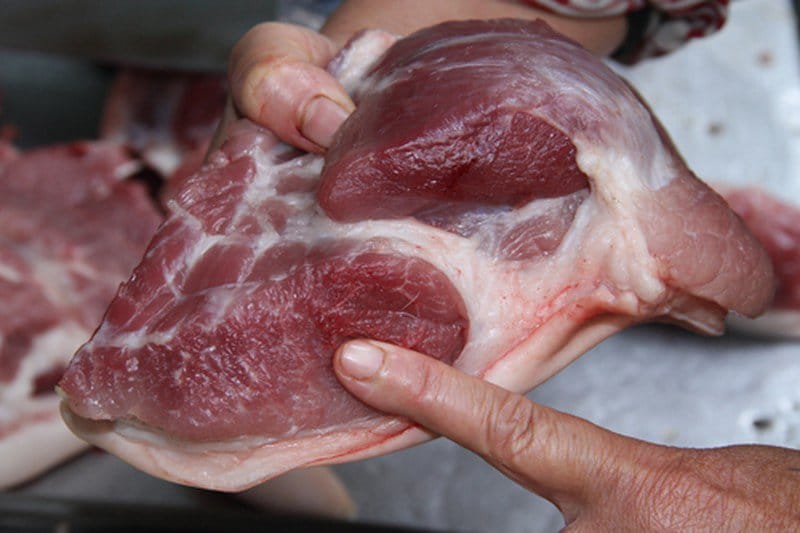
When pork is fresh, it is a healthy source of protein. However, when pork spoils, it can become a health hazard. Spoiled pork can contain various dangerous bacteria, such as Salmonella, E. coli, and Clostridium botulinum, which can cause food poisoning. Eating spoiled pork can lead to severe symptoms such as fever, chills, nausea, vomiting, abdominal cramping, and diarrhea. In extreme cases, it can even lead to death.
Consuming spoiled pork can be very dangerous, so taking food safety precautions and practicing proper food storage is important. If you’re in doubt, don’t eat pork that may be past its prime. Following the tips outlined above, you can reduce your risk of consuming spoiled pork and enjoy a delicious, healthy meal.
How Long Does Pork Typically Last Before Going Bad?
Based on factual data, cooked pork should be used within three to four days if refrigerated at 40 °F or less. Pork roast defrosted in the fridge can be kept in the refrigerator for 3 to 5 days before cooking. Fresh pork chops, ground pork, loin, and shoulder can last 2 to 3 days in the fridge. Frozen pork should be kept for 3 to 5 days for whole cuts and up to two days for ground pork. Pork can last 1-2 days beyond the “sell by” date, but freezing can prolong its shelf life.
Typically, pork roasts outlast ground pork, and pork loin can last up to five days in the refrigerator if stored properly. Remember to prevent freezer burn by overwrapping the original packaging in aluminum foil or plastic wrap or placing it in a resealable freezer bag.
How To Tell If Pork Is Bad?
If you’re unsure about the freshness of your pork, it can be helpful to know a few key signs of spoilage. An excellent place to start is with a sniff test – if the meat emits a sour or unpleasant odor, it may not be safe to eat. Look for any grey or green coloring and a slimy or mushy texture. Fresh pork should have no odor and a firm, tender feel. While it can be tempting to ignore these warning signs and try to salvage the meat, it’s generally best to avoid caution and discard anything that shows clear spoilage.
Let’s get into detail:
1. Use Your Sense of Smell
Your nose is a great indicator of whether pork is bad or not. If the pork has a sour, ammonia-like odor or a rancid smell, you should get rid of it. If the pork smells pleasant, it’s probably still good.
2. Check for Gray Coloration
If you notice any gray or greenish coloration on the pork, then it’s a good indicator that it’s bad. Once pork starts to turn gray, you should throw it out.
3. Look for a Slimy Texture
If the pork feels slimy, then it’s bad. Please don’t take any chances with slimy pork, as it’s a sure sign that it’s unsafe to eat.
4. Check for Discoloration
When pork is fresh, it has a glossy and creamy white color. If you notice any discoloration, your pork has likely gone bad. Discoloration can range from yellowish to brownish to greenish or even pink, so it’s essential to check the color of your pork before using it.
5. Check the Meat Tissue Consistency
When pork is fresh, it has a firm and moist texture. If it feels slimy or sticky, your pork has likely gone bad. If you press your finger against the pork and it doesn’t bounce back, it’s also a sign that your pork has gone bad.
6. Beware of Sour or Rancid Smells
When pork is fresh, it should have a mild smell that is not too strong. If your pork has a sour or rancid smell, it’s a sign that it has gone bad.
7. Check for Sticky Substances
One way to tell if pork is bad is to check for any sticky substances on the meat. If you see any sticky residue or slimy texture, the pork is likely spoiled and should not be used. This is a sign that bacterial growth has started and should not be eaten.
8. Trust Your Instincts
When it comes to food safety, it’s always essential to trust your instincts. If a piece of pork looks off in any way, then it’s best to toss it out. This could include changes in the pork’s color, texture, or smell. If anything about it looks suspicious, it’s best to start fresh with a new piece.
9. The Expiration Date
Another way to tell if pork is bad is to check the expiration date. Pork should be stored in the refrigerator three to four days after purchase. If the expiration date has passed, the pork should not be used. It’s also important to check the date when you first purchase the pork, as you don’t want to buy something close to expiration.
10. Puffed Up Packaging
Finally, if the pork packaging is puffed up or swollen, then the pork has likely gone bad. This is a sign that the pork is unsafe to eat and should be tossed out.
How To Know If Pork Is Bad After Cooking
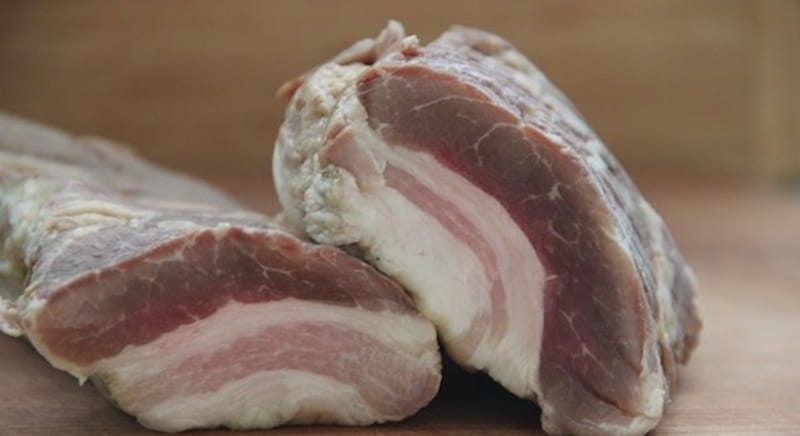
Using your senses is the easiest way to know if pork is bad after cooking. The most obvious sign that pork has gone bad is a bad smell. If it smells off or sour, it’s best to discard it.
In addition to smell, you can also use your eyes to tell if pork is bad. If the pork is grayish or yellowish, it’s likely gone bad and should be thrown away.
If the pork has been cooked properly, it should be light pink. It should also be firm to the touch and not slimy. If it feels slimy or soft, it has likely gone bad.
Use your nose and eyes to determine if pork is bad when in doubt. If it doesn’t look or smell right, it’s best to discard it.
Another way to tell if pork is bad after cooking is to look at its expiration date. All pork should have an expiration date, and paying attention to it is important. If the pork has been stored past its expiration date, it’s best to discard it.
Finally, make sure to cook pork thoroughly. Pork should be cooked to an internal temperature of 145 degrees Fahrenheit. To check the temperature, insert an instant-read thermometer into the thickest part of the pork. The pork should be cooked longer if the thermometer reads anything lower than 145 degrees Fahrenheit.
By using your senses and paying attention to expiration dates, you can easily tell if pork is bad after cooking. If the pork doesn’t pass the smell or visual test or has been stored past its expiration date, it’s best to discard it.
How To Tell If Marinated Pork Is Bad
Using your senses is the best way to tell if your marinated pork is bad. The meat’s smell, texture, and color can all provide clues as to whether it has gone bad.
Marinated pork may be past its prime if it has a strong odor. The smell should be pleasant and not overly foul. If the smell is off, throwing the pork away is best.
The texture of the marinated pork can also tell you if it is past its prime. The meat should be firm and not slimy or mushy. If the texture is off, throwing the pork away is best.
The color of the marinated pork can also be a good indicator. If the pork is discolored or has visible mold, it’s best to throw it out.
Finally, if the expiration date on the package has passed, it’s best not to eat the marinated pork. Even if the pork looks and smells okay, eating it could be unsafe.
How To Tell If Pork Is Bad After Freezing
Let’s look at how to tell if pork is bad after freezing.
- Color: A color change is one of the most obvious indicators that pork has gone bad. If the pork looks gray or has a greenish hue, the pork has likely begun to spoil. It is generally safe to eat if the pork looks pinkish or reddish.
- Odor: Spoiled pork will often have a sour or rancid smell. To be safe, always smell your pork before cooking or eating it.
- Texture: When pork is bad, it will often become slimy or sticky. If you notice a slimy or sticky texture to your pork, the pork has likely gone bad.
- Freezer Burn: If the pork has freezer burn, it is unsafe to eat. Freezer burn occurs when moisture is lost from the pork due to air exposure, resulting in dry, white patches.
- Date: If you’ve had the pork in the freezer for longer than the recommended time, it’s best to throw it away. While pork can last up to six months in the freezer, it’s safer to err on the side of caution and replace it with a fresher batch.
Following these guidelines, you can easily determine if your pork is still safe to eat after being frozen. Remember always to use caution when consuming any food stored in the freezer. Additionally, you should always check the expiration dates of any food you purchase to ensure it is safe to consume.
How To Tell If Ground Pork Is Bad
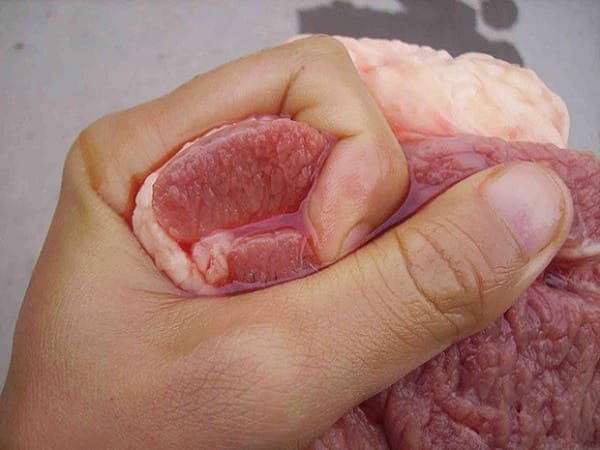
When it comes to ground pork, its shelf life is relatively short. It should be used within two days of purchase, or else it will start to spoil. This means that it’s essential to know how to tell if ground pork is bad.
- The first step is to look at the color of the ground pork. It should be bright pinkish-red, with no grey or green spots. If the meat is discolored, it’s best to avoid using it.
- The next step is to smell the ground pork. If it has a sour or ammonia-like smell, this is a sign that it has gone bad. You can also check for any slimy or sticky residue on the meat. If the ground pork has any of these signs, it’s best to discard it.
- Ground pork should have a slightly sweet flavor when it comes to taste. If it tastes sour or off, this is another sign that it has gone bad. It’s best to avoid eating ground pork that tastes bad.
- Finally, if you’re ever uncertain about ground pork, you can always check the expiration date. If the date has passed, it’s best to err on caution and discard it.
Read more:
What Are The Best Practices For Determining The Freshness Of Pork In Its Packaging?
- Always trust your nose: The first and surest way to determine the freshness of pork in its packaging is by using your sense of smell. If the pork smells unpleasant or foul, it’s best to avoid it.
- Check the packaging: If the packaging prevents you from smelling the pork, check the packaging for any signs of damage or punctures. Damaged packaging could indicate contamination or spoilage.
- Look at the color: Fresh pork should have a grayish-pink color. The pork may be spoiled if it appears discolored or has a greenish tint.
- Examine the texture: Fresh pork should be moist and satin-like. The pork may be past its prime if it feels slimy or sticky.
- Check for excess liquid: It’s normal for fresh pork to release a small amount of liquid in its packaging. However, if there is excessive liquid or it appears slimy, the pork may be spoiled.
- Avoid strong odors: Fresh pork should not have a strong or unpleasant odor.
- Consider the taste: Fresh pork should taste sweet and clean. The pork may be past its prime if it tastes gamey or has an off-flavor.
What Mold Growth Can Occur On Pork?
Have you ever wondered about the mold that can grow on pork? Mold is a fungus that can grow on food, including pork. There are good molds and bad molds, and it’s important to know the difference. Good mold found on artisanal cured meat should look white and fuzzy, and it acts as a protective mesh of microorganisms that keep the salami or dried sausages from developing bad toxic mold. The standard good mold for artisanal cured meats is Penicillium, and it is perfectly safe to eat.
On the other hand, bad mold on pork can be green or black and can cause serious health problems for humans and animals when consumed. To prevent bad toxic mold from overtaking cured meats, storing them in a separate fridge or cold pantry away from fresh fruits and vegetables is best. So, if you come across mold on your pork, be sure to get rid of it and pay attention to what kind of mold it is to ensure food safety.
Can A Slimy Film On Pork Indicate Spoilage?
One of the biggest signs of spoiled pork is a slimy film on the meat’s surface, which is a surefire indicator that bacteria have already started to grow. Once the meat has started to spoil, refrigeration or cooking will not make it safe to consume. Therefore, when in doubt, it’s better to discard the meat and avoid any possible health risks.
What Causes Premature Spoilage?
1. Air quality
Air quality affects the shelf life of food, from the first steps in food processing to storage, shipping, and handling by distributors and grocers until it reaches the consumer’s plate. Industrial-grade HVAC systems and separate industrial air filtration systems for capturing different-sized air contaminants, including microbial contamination like molds, yeasts, and bacteria, are essential in certified food and beverage processing plants.
2. Temperature
Food requires specific temperature ranges for storage, preparation, and cooking. Inappropriate temperature control can trigger the growth of spoilage microorganisms and pathogenic bacteria that can lead to food poisoning.
3. Moisture content
Moisture content is another crucial factor that influences food spoilage. Too much moisture leads to the growth of bacteria and fungi, while too little can cause dryness and shriveling of produce and other foods.
4. Physical damage
Physical damage from rough handling or improper packaging can cause contamination and accelerate spoilage. Foods that are bruised, piercing, or damaged should be discarded.
5. Chemical reactions
Oxidation, a chemical reaction when foods are exposed to air, can lead to rancidity, off-flavors, and color changes. Chemical reactions can also occur when mixing incompatible food ingredients.
What Is The Difference Between Bad Pork And Expired Pork?
It can be difficult to understand the difference between bad pork and expired pork when buying pork. After all, both are essentially spoiled meat and can cause food poisoning if consumed. But while both present similar risks, there are some key differences between bad pork and expired pork.
Bad pork is pork that has not been stored properly. It may have been exposed to high amounts of heat, light, or oxygen, which can cause spoilage. This type of pork may also have been exposed to bacteria or various microorganisms that can contaminate it. The key to identifying bad pork is to look for visible signs such as discoloration, an off-odor, or a slimy texture.
On the other hand, expired pork is past its expiration date. This type of pork is more likely to contain harmful bacteria or microorganisms that can cause food poisoning. The key to identifying expired pork is to look for the expiration date on the package. If the date has passed, the pork should be discarded.
Remember, bad and expired pork can have serious health implications, so always practice good food safety habits.
Is It Safe To Eat Pork That Is Discolored?

Experts say fresh pork should be light pink with firm white fat. However, if the meat seems paler or gray, it is still safe for consumption. The pinkish color in pork is caused by oxygen exposure, and it can vary depending on factors such as enzymes and fat content. Meanwhile, a yellowish or greenish hue is a red flag that the meat is no longer fresh. Eating bad pork can cause food poisoning, so it’s essential to use your senses to check for any signs of spoilage.
Can You Still Eat Pork That Smells Odd?
If you notice that your pork smells odd, it’s best to err on caution and not consume it. Foul odors like ammonia, fish, gas, or sulfur strongly indicate that the meat is no longer good. If the pork has a sour or rancid odor, it’s time to toss it. While some types of meat may be salvaged with cooking, it’s not worth risking food poisoning over spoiled pork. Trust your nose and discard any pork that smells questionable to keep yourself and your loved ones safe.
What Is The Best Way To Store Pork To Prevent Spoilage?
Based on factual data, the best way to do so is by keeping the meat below 40°F in a refrigerator or freezing it if it won’t be used within a few days. Storing uncooked pork items together, separate from cooked foods, and paying attention to “packed on” or “use by” dates are also vital. Meat spoilage bacteria can cause illness, so keeping meat at a safe temperature is important to prevent these organisms from growing. Additionally, it’s best to thaw pork slowly and safely in the refrigerator rather than at room temperature.
Can You Still Cook Pork That Has Gone Bad?
It’s important to ensure that the pork you cook is fresh and free from spoilage, as pork that has gone bad cannot be restored to a safe, edible state. If the pork has a sour or unpleasant odor, has turned brown or grey, or feels slimy to the touch, it has gone bad and should not be cooked or consumed. Eating bad pork can lead to illness, and no guarantee cooking it will kill all the developed bacteria and toxins. To avoid the risk of food poisoning, it’s best to always check the freshness of your pork before cooking it and discard any meat that has gone bad.
What Are Some Common Mistakes People Make When Handling Pork?
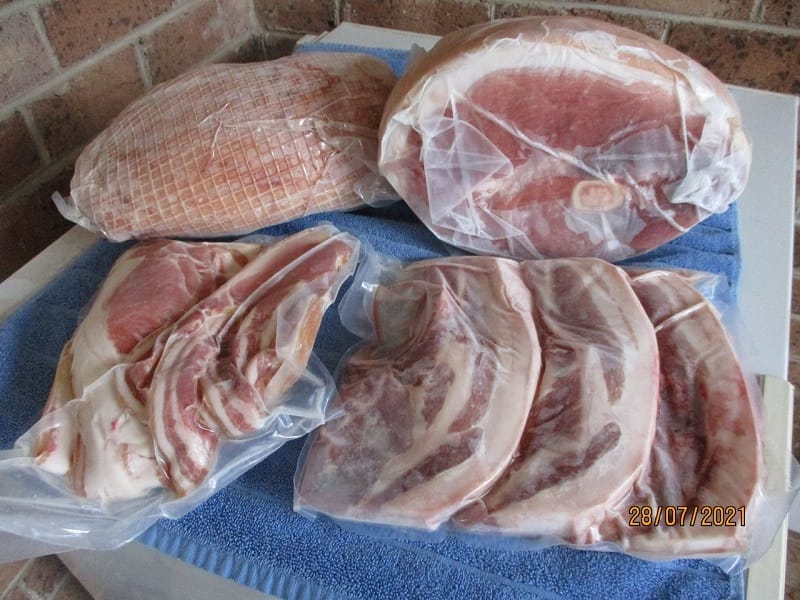
Here are some common mistakes people make when handling pork:
- Not allowing the pork to reach room temperature before cooking. Allowing the pork to rest at room temperature will help it cook more evenly and prevent it from becoming tough.
- You are not using a thermometer. A thermometer is an essential tool for cooking pork because it allows you to check the internal temperature of the meat to make sure it is cooked through.
- You are not seasoning the pork. Adding spices and herbs to pork can bring out the flavor. Make sure to season your pork well before cooking.
- Not allowing the pork to rest after cooking. Allowing the pork to rest after cooking will help it retain its moisture, making it more tender and juicy.
- I was overcooking the pork. Overcooking will dry out the pork, making it tough and chewy. Be sure to keep an eye on the thermometer to ensure your pork doesn’t get overcooked.
What Are Some Tips For Safely Handling And Preparing Pork To Prevent Spoilage?
Here are some tips for safely handling and preparing pork to prevent spoilage:
- Purchase fresh pork. When selecting pork, inspect the package for any signs of spoilage such as discoloration, off smells, or an unusually slimy texture. If any of these signs are present, do not purchase the pork.
- Store pork in the refrigerator or freezer. Pork should be stored in the refrigerator at 40 degrees Fahrenheit or below. It should be placed in the freezer if you plan to store it for over two days.
- Use separate cutting boards and utensils for pork. It is important to use separate cutting boards and utensils for pork to prevent contamination from other foods. Bacteria from raw pork can contaminate other foods, leading to foodborne illness.
- Cook pork thoroughly. Pork should be cooked to an internal temperature of at least 145 degrees Fahrenheit. Use a meat thermometer to check the internal temperature of the pork.
- Avoid leaving cooked pork out at room temperature. Cooked pork should not be left at room temperature for over two hours. After the two-hour mark, bacteria can quickly grow on the pork, leading to foodborne illness.
FAQs About How To Tell If Pork Is Bad
Can You Eat Pork That Has Been In The Refrigerator For A Week?
According to factual data, cooked pork should only be stored in the fridge for up to four days, while fresh, uncooked pork can last up to five days. However, if the pork has been stored properly below 40 degrees Fahrenheit, eating it up to five days after cooking may still be safe.
On the other hand, if the pork has been frozen and thawed, it may last up to five days in the refrigerator but should be cooked and consumed. It’s always better to err on the side of caution when it comes to food safety, and if in doubt, it’s best to throw it out.
Pork Smells Bad, But It’s Not Expired?
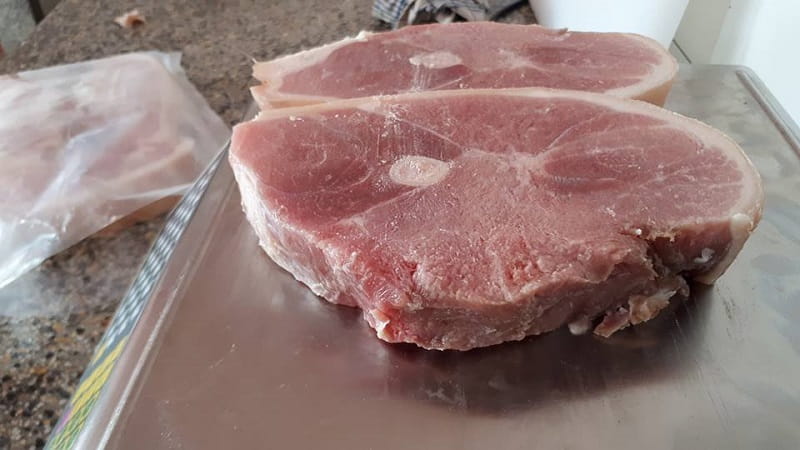
If anyone ever encounters a situation where their pork smells bad but hasn’t expired yet, they need not worry. According to factual data, sometimes the cryovac packaging can emit a mild sulfury smell in raw pork, which should be safe to eat. However, one should still be cautious and make sure that the smell is not sour or ammonia-like, which could indicate that the pork has gone bad. If the odor is not too unpleasant, one can go ahead and cook and eat the pork. Always remember to trust your sense of smell when it comes to food you are unsure about.
Conclusion
If you notice any of these signs, throwing the pork away is best to avoid health risks. It’s also essential to store pork properly and use it within a few days of purchasing it. This will ensure that you’re enjoying the freshest and safest pork.
Now that you know how to tell if pork is bad, be sure to try out this recipe! Let me know how it turns out in the comments below.
References:
- https://oureverydaylife.com/can-eat-pork-smells-bad-cook-long-enough-40395.html
- https://www.tastingtable.com/829436/warning-signs-your-pork-has-gone-bad/
- https://www.simplyhealthyfamily.org/how-can-you-tell-if-pork-is-spoiled/

Hey readers! Chip Holland here, and I’m a Manager of this website. My passion for writing about it only matches my passion for BBQ. Follow my blog for mouth-watering recipes, tips, and tricks for the perfect smoke, grill, and BBQ. I’m sure you won’t be disappointed!
